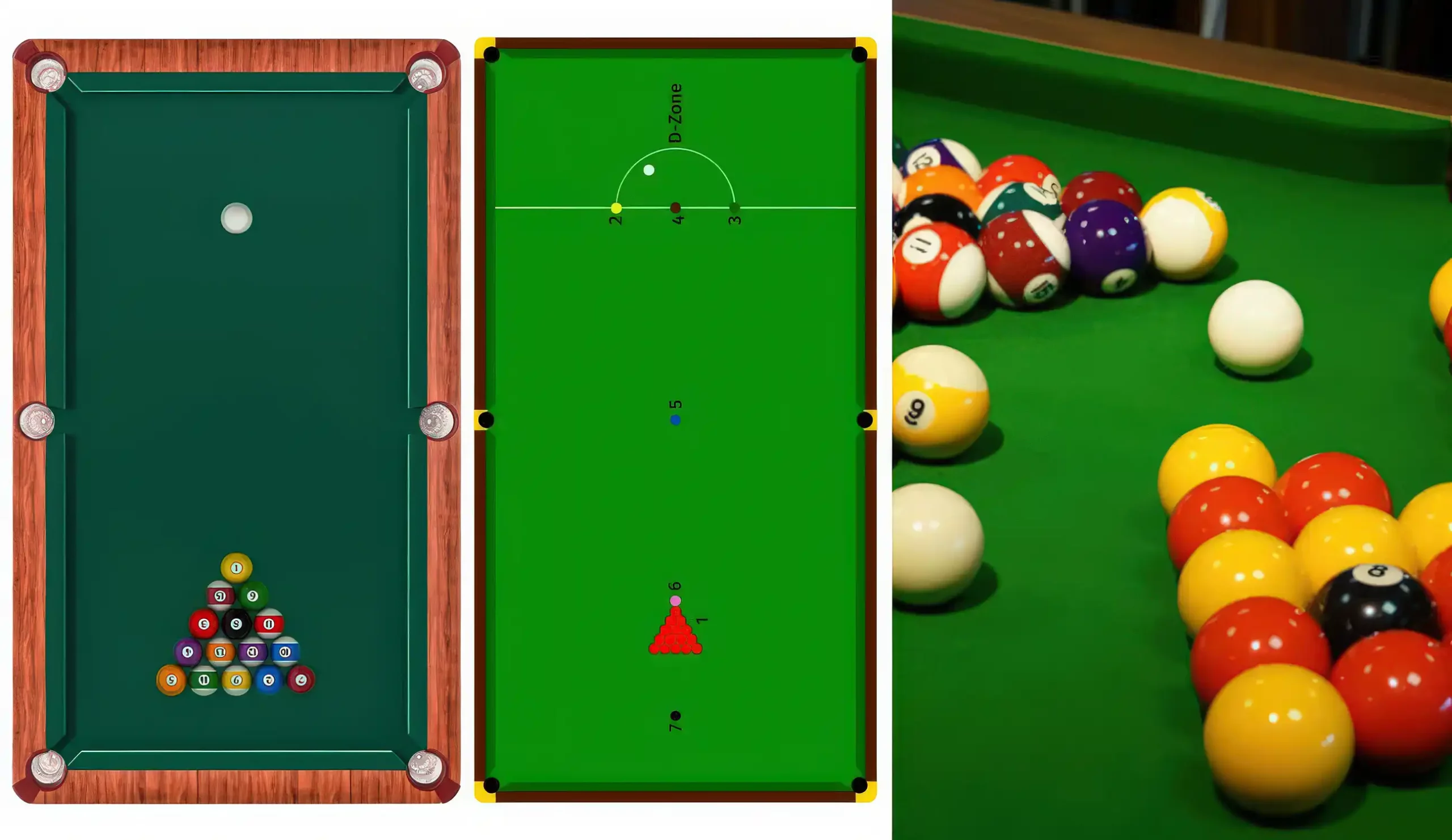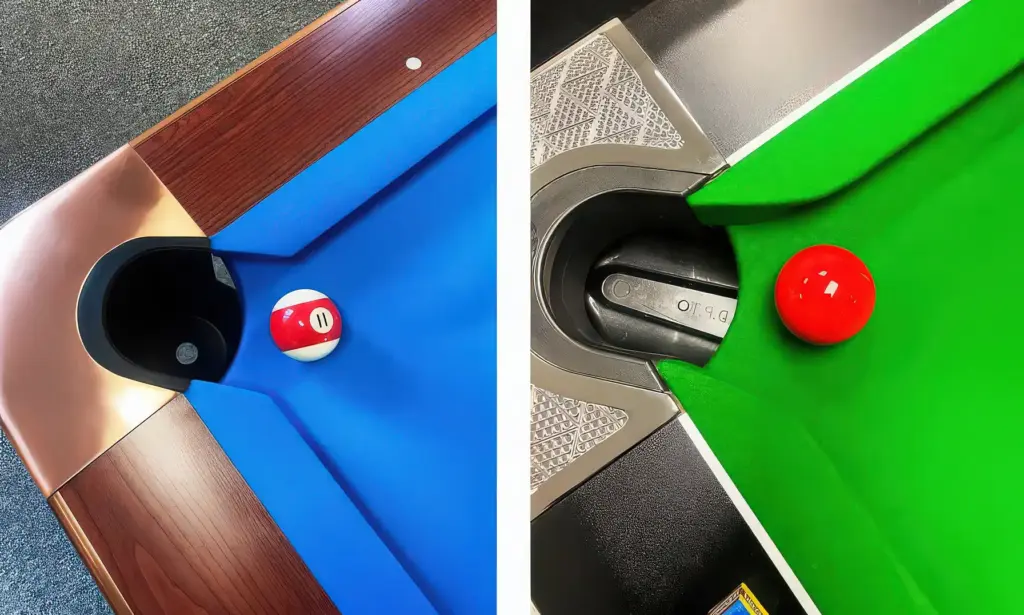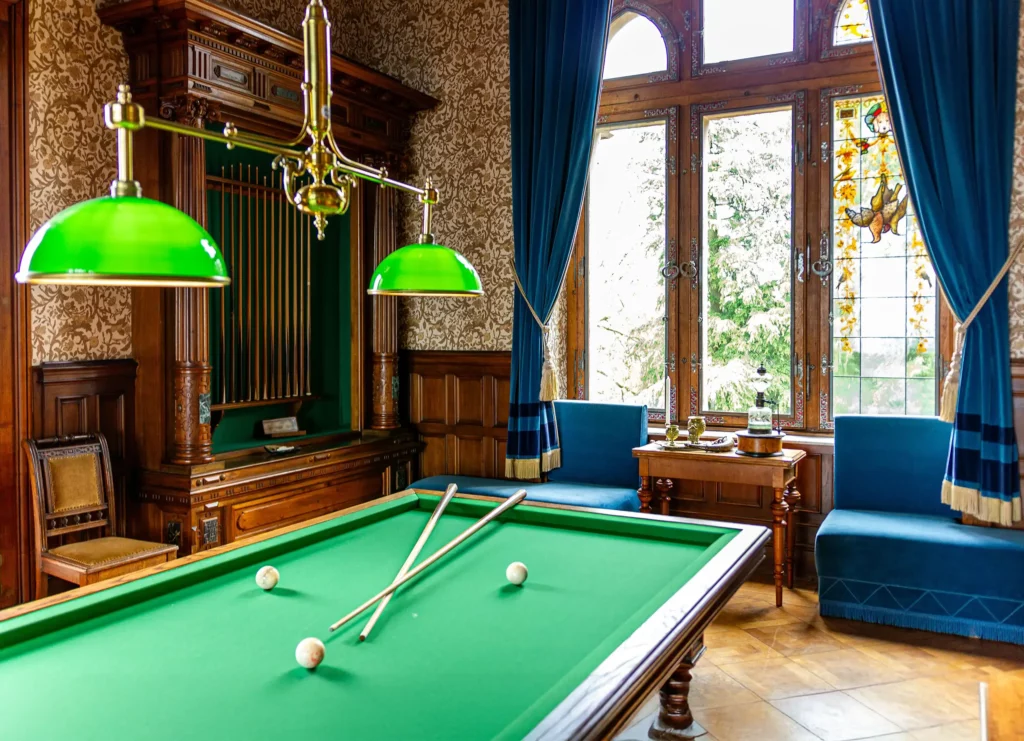Have you ever found yourself in a game room, ready to enjoy a game of cue sports, only to pause and wonder: “Is this pool or billiards?” Many enthusiasts, both new and seasoned, often use these terms interchangeably, blurring the lines between distinct games that, while sharing a common ancestry, possess unique rules, equipment, and strategic demands. This common confusion can hinder your appreciation of these skillful games and even affect your equipment choices. This article aims to clarify the fundamental Pool and Billiards Differences, transforming your understanding from uncertainty to confident comprehension, and guiding you towards becoming a more discerning player and owner of cue sports equipment.
Introduction
The realm of cue sports offers a rich tapestry of engaging and skillful games. While “pool” and “billiards” are popular and often confused, their fundamental distinctions are significant. This report will clearly delineate the key characteristics that set pool apart from billiards, providing a comprehensive understanding of their unique rules, equipment, and strategic nuances. By exploring the historical context, examining the regulations of popular variations, comparing equipment specifications, and contrasting strategic elements, you’ll gain a thorough perspective on what makes these cue sports distinct. Understanding these Pool and Billiards Differences is the first step in enhancing your enjoyment and mastery of the game.
Defining Pool and Billiards: A Matter of Scope and History
To truly grasp the Pool and Billiards Differences, it’s essential to understand their historical evolution and scope. What might seem like a minor distinction is actually a fundamental divergence in game design.
Billiards: The Umbrella Term
Billiards, in its broadest sense, serves as an overarching term for several games played on an oblong table. These games involve propelling small balls with a cue stick, aiming to either strike them against each other or direct them into pockets. Historically, the term “billiards” predates “pool” and was the original, more encompassing designation for cue sports, tracing its origins back to 15th-century Northern Europe. The term “pool” has an interesting historical connection to betting practices associated with billiards games, particularly in 19th-century America. In British English, “billiards” retains this broader meaning, encompassing games played on rectangular tables with cushioned edges. More specifically, it can refer to games where points are scored by causing the cue ball to successively hit two object balls—a core mechanic known as the carom.
Carom billiards, also known as French billiards, is a prominent form played with three balls (two white, one red) on a table without pockets. The objective is to strike the two object balls in succession with the cue ball, scoring one point per carom.
English billiards and snooker are other popular variations played on tables with pockets. This historical precedence highlights that understanding the fundamentals of billiards provides a crucial conceptual foundation for appreciating the specific characteristics of pool.
Pool: A North American Specialization
Pool, in contrast, refers specifically to cue sports played on a billiard table that features six pockets along its rails. In American English, “pool” is frequently synonymous with pocket billiards, emphasizing the defining characteristic of pockets. The term “pool” has an interesting historical connection to 19th-century American betting practices, initially referring to gambling pools associated with billiards games. As a variant played with sixteen balls gained prominence, “pool” gradually came to refer to this specific game and eventually to the broader category of pocket billiards. Numerous popular variations of pool exist, each with unique rules and objectives, including:
- Eight-ball: Often considered synonymous with “pool” due to its popularity.
- Nine-ball: A race to pocket the 9-ball.
- Straight pool (14.1 continuous): A continuous game where players aim for a predetermined score.
- One-pocket: A strategic game where players choose a single pocket to score.
- Bank pool: Shots must involve banking the object ball off a rail before pocketing.
Each variation utilizes the six pockets of the table as integral to gameplay. This specialization of terminology in America for games played on tables equipped with pockets underscores a fundamental difference from many traditional billiards games, such as carom billiards, which are played on tables without pockets. This divergence in table design dictates the fundamental ways in which the games are played and scored, serving as a crucial aspect in understanding the key Pool and Billiards Differences.
Exploring the Rules of Pool: Pocketed Precision
Pool games, defined by their pockets, demand precision and strategic shot-making to pocket object balls. Mastering these rules is key to navigating your ‘Hero’s Journey’ from novice to confident player.
8-Ball: The Most Popular Variant
Eight-ball is perhaps the most widely played discipline of pocket billiards.
-
- Objective: Pocket all balls from your assigned group (solids 1-7 or stripes 9-15), then legally pocket the 8-ball.
- Equipment: One cue ball, fifteen object balls (1-15: solids and stripes), and the distinct black 8-ball.
- Gameplay:
- Call Shot: Most shots require calling the intended object ball and pocket, though obvious shots may be exempted. The opening break does not require a call.
- Racking: Balls are racked in a triangle with the 8-ball in the center, the 1-ball at the apex, and a stripe and solid ball in the rear corners.
- Break Shot: Must pocket an object ball or drive at least four numbered balls to a rail. Fouls on the break offer options to the incoming player.
- Open Table: After the break, no group is assigned until a player legally pockets a called object ball.
- Continuing Play: Players continue their turn as long as they legally pocket balls from their group.
- Shooting the 8-Ball: After pocketing all group balls, the 8-ball becomes the legal object. Fouling while pocketing the 8-ball or pocketing it prematurely results in a loss of game.
- Fouls: Common fouls include scratching the cue ball, jumping balls off the table, hitting the wrong group first, or failing to contact a rail after cue ball contact. Fouls result in “ball in hand” for the opponent. Three consecutive fouls do not result in a loss of game in 8-ball.
The rules of 8-ball necessitate a blend of offensive and defensive game of strategy, focusing on precision and foresight to clear your group and win.
9-Ball: Race to the Nine
Nine-ball offers a faster-paced game with a different strategic focus.
- Objective: To win the game by legally pocketing the 9-ball.
- Equipment: One cue ball and nine object balls, numbered from 1 through 9.
- Gameplay:
- Lowest Number First: On each shot, the cue ball must first contact the lowest-numbered object ball on the table. Balls do not need to be pocketed in numerical order.
- No Call Shot (Generally): Players are typically not required to call ball or pocket. A “safety” can be declared, ending the turn after the shot.
- Racking: Balls are racked in a diamond shape, with the 1-ball at the apex and the 9-ball in the center.
- Break Shot: The breaker must strike the 1-ball first and either pocket a ball or drive at least four balls to a rail. Pocketing the 9-ball on a legal break wins the rack.
- Push Out: After a legal break, the shooter can play a “push out” to reposition the cue ball. The incoming player can then shoot or pass the shot back.
- Continuing Play: Players continue until they miss, foul, or pocket the 9-ball.
- Fouls: Fouls award the incoming player “ball in hand.” The 9-ball is spotted if pocketed on a foul or driven off the table. Three consecutive fouls result in a loss of the current rack.
Nine-ball strategy centers on creating opportunities to legally pocket the 9-ball, often involving efficient movement through lower-numbered balls. The unique push out rule adds a strategic dimension immediately after the break. Understanding the condition of your pipes is the first step to avoiding future headaches and achieving peace of mind, guiding you toward a durable home.
Exploring the Rules of Billiards: Caroms and Cushions
Billiards, particularly carom variations, requires a deep understanding of angles, cue ball control, and cushion play, distinctly different from pocketing.
Three-Cushion Billiards: A Test of Precision
Three-cushion billiards is a highly precise carom game.
- Objective: Score a point (carom) by having the cue ball contact both object balls (opponent’s cue ball and red ball) and make contact with at least three or more cushions before contacting the second object ball.
- Equipment: Played on a specialized pocketless table (typically 5×10 feet) with three balls: one white cue ball for one player, one yellow cue ball (or white with a spot) for the opponent, and one red object ball.
- Gameplay:
- Scoring: Each successful carom scores one point. The first player to reach a predetermined score (e.g., 15-25 points) wins. Cushion contacts can be repeated on the same cushion.
- Break Shot: Requires striking the red ball first.
- Continuing Play: Players continue as long as they score a carom on each shot.
- Fouls: Fouls end the player’s turn but typically do not incur point penalties.
Three-cushion billiards demands exceptional precision and strategic thinking, focusing on angles and rebounds to achieve the necessary three cushion contacts.
Straight Rail Billiards: The Foundation of Carom Games
Straight rail, also known as three-ball billiards or the free game, is a foundational carom game.
- Objective: Score points (caroms or counts) by striking the player’s cue ball to make contact with both the opponent’s cue ball and the red object ball in the same stroke.
- Equipment: Played on a pocketless, unmarked billiard table (commonly 10×5 feet) with three balls: one white cue ball for each player and one red object ball.
- Gameplay:
- Scoring: A point (count) is scored each time the cue ball makes contact with both of the other two balls (the opponent’s cue ball and the red ball) in a single stroke, resulting in a carom.
- Break Shot: The cue ball must contact the red ball first. Subsequent shots can hit either the red or the opponent’s cue ball first.
- Continuing Play: A player continues as long as they score a carom on each shot.
- Crotch Rule: Prevents endless scoring in corners. If both object balls are in a corner “crotch,” a player is limited to three consecutive caroms; on the third, at least one object ball must be driven out of the crotch.
Straight rail requires high skill in controlling all three balls, with strategy revolving around creating and maintaining ideal scoring opportunities through precise cue ball control and “nurse” techniques.
Comparative Analysis of Equipment: Form Follows Function
The equipment used in pool and billiards is specifically tailored to the demands of each game, highlighting key Pool and Billiards Differences.
Table Dimensions: Size Matters
The most fundamental difference in table design is the presence of pockets in pool and their absence in carom billiards. This single feature dictates the primary objectives and gameplay mechanics of each sport.
- Pool Tables:
- Common Sizes: 7-foot, 8-foot, and 9-foot.
- Playing Area Ratio: 2:1 length-to-width ratio.
- Pockets: Yes (6 pockets).
- Typical Use: Home, Tournament, Bar.
- Billiards Tables (Carom Games):
- Common Sizes: 10 feet.
- Playing Area Ratio: Approximately 2:1.
- Pockets: No.
- Typical Use: Tournament, Billiard Halls.
Additionally, the larger size of standard carom tables compared to even the largest regulation pool tables (9-foot) provides a greater playing area, influencing the types of shots and strategies employed.
| Feature | Pool | Billiards (Carom) |
| Common Sizes | 7 ft, 8 ft, 9 ft | 10 ft |
| Playing Area Ratio | 2:1 | Approximately 2:1 |
| Pockets | Yes (6) | No |
| Typical Use | Home, Tournament, Bar | Tournament, Billiard Halls |
Ball Specifications: Distinct Properties
The balls used in pool and billiards also differ significantly in their size and weight, impacting their behavior on the table.
- Pool Balls:
- Diameter: 2 1/4 inches (57.15 mm).
- Weight: 5.5 – 6.0 ounces (approx. 160-170 grams).
- Material: Phenolic Resin.
- Billiards Balls (Carom Games):
- Diameter: 61-61.5 mm (approx. 2 13/32 – 2 7/16 inches).
- Weight: 7.2 – 7.8 ounces (approx. 205-220 grams).
- Material: Phenolic Resin.
| Feature | Pool | Billiards (Carom) |
| Diameter | 2 1/4 inches (57.15 mm) | 61-61.5 mm (approx. 2 13/32 – 2 7/16 in) |
| Weight | 5.5 – 6.0 ounces (approx. 160-170 grams) | 7.2 – 7.8 ounces (approx. 205-220 grams) |
| Material | Phenolic Resin | Phenolic Resin |
Cue Stick Characteristics: Tools of the Trade
The cue sticks used in pool and billiards are also tailored to the specific demands of each game, with differences in length, weight, and tip size.
- Pool Cues:
- Length: 57-59 inches.
- Weight: 17-21 ounces.
- Tip Diameter: 12-14 mm.
- Typical Wood: Maple.
- Ferrule: Plastic or Fiber.
- Billiards Cues (Carom Games):
- Length: 54-56 inches.
- Weight: 16.5-18.5 ounces.
- Tip Diameter: 11-12 mm.
- Typical Wood: Maple, Ash.
- Ferrule: Shorter, possibly wood.
| Feature | Pool | Billiards (Carom) |
| Length | 57-59 inches | 54-56 inches |
| Weight | 17-21 ounces | 16.5-18.5 ounces |
| Tip Diameter | 12-14 mm | 11-12 mm |
| Typical Wood | Maple | Maple, Ash |
| Ferrule | Plastic or Fiber | Shorter, possibly wood |
The shorter, lighter nature of carom cues with their smaller tips is well-suited to the larger, heavier balls and the need for highly precise cue ball control in billiards, particularly on shots requiring side spin.
Strategic Elements and Skills Emphasized
The strategic demands of pool and billiards further highlight the Pool and Billiards Differences, requiring distinct skill sets.
Pool: A Game of Position and Pocketing
Pool strategy is heavily oriented towards the successful pocketing of object balls. This demands:
- Aiming Accuracy: Precise alignment to sink the intended ball.
- Cue Ball Control: Manipulating speed and direction for favorable position play.
- Strategic Shot Selection: Deciding which balls to pocket and in what order.
- Safety Play: Leaving opponents without clear shots or snookered.
- Effective Break Shots: Spreading balls advantageously for an open rack.
The presence of pockets fundamentally shapes pool strategy, making aiming for successful potting a primary skill.
Billiards: Mastery of Angles and Cushions
Billiards, particularly carom games, emphasizes a different set of skills:
- Precision Carom Execution: Controlling the cue ball’s trajectory to contact specific object balls.
- Understanding Angles and Rebounds: Crucial for utilizing cushions to achieve necessary contacts.
- Intricate Shot Planning: Especially in three-cushion billiards, planning sequences of cushion contacts.
- “Nurse” Techniques: Delicate cue ball control to keep object balls close for continuous scoring in straight rail.
The absence of pockets means strategic focus is on controlling the final positions of the balls to extend scoring runs rather than aiming for specific pockets.
FAQ
What is the primary difference between pool and billiards?
The primary difference between pool and billiards lies in the table design: pool tables have six pockets, while billiards (specifically carom billiards) tables are pocketless. This fundamental distinction dictates the objectives and gameplay mechanics of each sport.
What are the most popular variations of pool?
The most popular variations of pool include 8-ball, 9-ball, straight pool (14.1 continuous), one-pocket, and bank pool. Each of these games utilizes the six pockets on the table.
What is a carom in billiards?
In billiards, a carom (or billiard) is a point scored when the cue ball makes contact with two other object balls in a single stroke. In three-cushion billiards, the cue ball must also contact at least three cushions before hitting the second object ball to score a point.
Are cue sticks different for pool and billiards?
Yes, cue sticks for pool and billiards (carom) differ. Carom cues tend to be shorter, lighter, and have smaller tips (11-12 mm) compared to pool cues (12-14 mm). Carom cues often have a stiffer construction to aid in precision for shots requiring side spin.
Does Hallmark Billiards offer both pool and billiards equipment?
Hallmark Billiards specializes in a comprehensive range of high-quality game room equipment, including a wide selection of pool tables from brands like Brunswick and Olhausen, various pool table accessories like pool cues and balls, and game room furniture. While their primary focus is on pocket billiards (pool), their expertise extends to all cue sports needs.
Conclusion
While both pool and billiards fall under the umbrella of cue sports and demand high skill and precision, they represent distinct categories of games with unique rules, equipment, and strategic nuances. The presence or absence of pockets is the most fundamental Pool and Billiards Difference, dictating the core mechanics and objectives. Pool focuses on the strategic pocketing of balls, while billiards, especially carom games, emphasizes the art of the carom through precise cue ball manipulation and an understanding of table geometry. Although the terms might occasionally be used interchangeably in casual conversation, the fundamental differences in gameplay, equipment, and objectives ensure that pool and billiards offer significantly different and equally engaging experiences for enthusiasts. Now, equipped with this understanding, you can confidently navigate the world of cue sports, recognizing the distinct beauty and challenges of each game.
For professional pool table and billiard services in Ontario, contact Hallmark Billiards today, and take the next step in your journey to a better game room.




